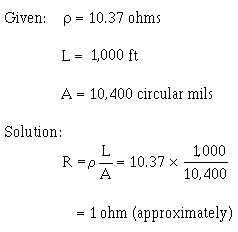1-6
Problem:
What is the resistance of 1,000 feet of copper wire having a cross-sectional area of 10,400 circular
mils (No. 10 wire) at a temperature of 20º C?
Solution:
The specific resistance of copper (table 1-1) is 10.37 ohms. Substituting the known values in the
preceding equation, the resistance, R, is determined as
If R, !, and A are known, the length (L) can be determined by a simple mathematical transposition.
This has many valuable applications. For example, when locating a ground in a telephone line, you will
use special test equipment. This equipment operates on the principle that the resistance of a line varies
directly with its length. Thus, the distance between the test point and a fault can be computed accurately.
Q7.
Define specific resistance.
Q8.
List the three factors used to calculate resistance of a particular conductor in ohms.
WIRE SIZES
The most common method for measuring wire size in the Navy is by using the American Wire
Gauge (AWG). An exception is aircraft wiring, which varies slightly in size and flexibility from AWG
standards. For information concerning aircraft wire sizes, refer to the proper publications for specific
aircraft. Only AWG wire sizes are used in the following discussion.




